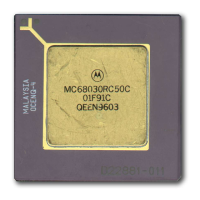Bus Operation
7-6
MC68030 USER’S MANUAL
MOTOROLA
For synchronous bus cycles, external devices assert the synchronous termination signal
(STERM
) as part of the bus protocol. During a read cycle, the assertion of STERM causes
the processor to latch the data. During a write cycle, it indicates that the external device has
successfully stored the data. In either case, it terminates the cycle and indicates that the
transfer was made to a 32-bit port. Refer to
7.3.2 Asynchronous Write Cycle
for timing
relationships of STERM
.
The bus error (BERR
) signal is also a bus cycle termination indicator and can be used in the
absence of DSACKx
or STERM to indicate a bus error condition. It can also be asserted in
conjunction with DSACKx
or STERM to indicate a bus error condition, provided it meets the
appropriate timing described in this section and in MC68030EC/D,
MC68030 Electrical
Specifications
. Additionally, the BERR
and HALT signals can be asserted together to
indicate a retry termination. Again, the BERR
and HALT signals can be asserted
simultaneously in lieu of or in conjunction with the DSACK
x or STERM signals.
Finally, the autovector (AVEC
) signal can be used to terminate interrupt acknowledge
cycles, indicating that the MC68030 should internally generate a vector number to locate an
interrupt handler routine. AVEC
is ignored during all other bus cycles.
7.2 DATA TRANSFER MECHANISM
The MC68030 architecture supports byte, word, and long-word operands allowing access
to 8-, 16-, and 32-bit data ports through the use of asynchronous cycles controlled by
DSACK0
and DSACK1. It also supports synchronous bus cycles to and from 32-bit ports,
terminated by STERM
. Byte, word, and long-word operands can be located on any byte
boundary, but misaligned transfers may require additional bus cycles, regardless of port
size.
When the processor requests a burst mode fill operation, it asserts the cache burst request
(CBREQ
) signal to attempt to fill four entries within a line in one of the on-chip caches. This
mode is compatible with nibble, static column, or page mode dynamic RAMs. The burst fill
operation uses synchronous bus cycles, each terminated by STERM
, to fetch as many as
four long words.
7.2.1 Dynamic Bus Sizing
The MC68030 dynamically interprets the port size of the addressed device during each bus
cycle, allowing operand transfers to or from 8-, 16-, and 32-bit ports. During an
asynchronous operand transfer cycle, the slave device signals its port size (byte, word, or
long word) and indicates completion of the bus cycle to the processor through the use of the
DSACKx
inputs. Refer to Table 7-1 for DSACKx encodings and assertion results.

